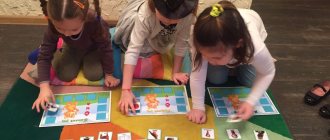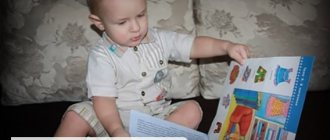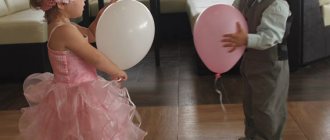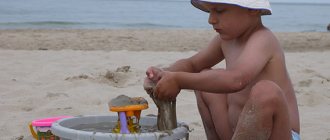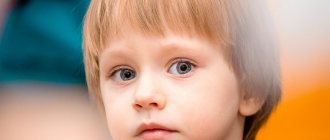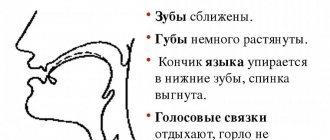A children's speech therapist is a specialist who corrects delays and disorders of speech formation at all stages. Children of different age groups may need the help of a speech therapist, but classes with a speech therapist-defectologist are most in demand and relevant during the period of preparing a child for school and developing his active learning skills.
By the age of five, a child should have developed clear, expressive speech with an extensive vocabulary and the ability to formulate complex sentences. If parents notice a delay or disturbance in speech function, they should contact a qualified speech therapist, which will prepare the child for school and simplify his adaptation to the children's team.
When is it necessary to contact a speech therapist?
Most child psychologists and pediatricians recommend sessions with a speech therapist before a child enters school, namely upon reaching five years of age. This helps to establish the correct pronunciation of sounds, achieve intonation expressiveness of speech and facilitate the child’s social adaptation in a new team. However, most often parents decide to take classes with a speech therapist if they have speech defects, which in children of five years of age can manifest themselves as the following speech disorders:
- Stuttering is a speech disorder accompanied by frequent repetition of words and prolongation of the pronunciation of certain sounds. This problem should be solved in preschool age, because later stuttering can cause complexes, shyness and isolation in the child.
- Any defects in sound pronunciation - if a child’s speech at five years old is slurred and unclear, creating the impression of “porridge in the mouth,” a visit to a speech therapist cannot be postponed. Problems in this case are most often associated with insufficient development or deviations in the structure of the speech apparatus.
- Dyslalia - many children at the age of 5 are very developed, smart and perfectly formulate their thoughts, while confusing some consonant sounds. We are most often talking about the pronunciation of “r”, “l” and “sh”;
- General speech underdevelopment (GSD) is manifested by the fact that the baby confuses prepositions and endings, incorrectly formulates sentences, and does not use complex phrases. OHP can be noticed as early as 3-4 years of age, but parents usually seek help only before the child enters school;
- Delayed speech development - if by the age of five the child does not speak all the words and cannot formulate his thoughts, perhaps we are talking about a speech disorder at the level of higher mental functions. In this case, you should contact a speech therapist-defectologist.
- Dyslexia and dysgraphia - already at the age of five, at the stage of a child’s active preparation for school, one can notice problems in mastering reading and writing, which can subsequently cause poor performance and lack of motivation to learn.
Learning to speak clearly
At 5 - 7 years old, a child is already able to repeat many exercises after a parent or teacher. But among them there are also complex ones. I tried to put together the simplest and most effective ones. By the way, they are also perfect for children with special needs.
Articulation gymnastics
- Smile so that your teeth are visible. And then we pull the sponges into a tube.
- Tighten your lips as hard as possible. Gently relax.
- Bite your upper and lower lips alternately with your teeth.
- Clattering of hooves. This is a well-known action. The kids will love it without a doubt!
15 minutes is enough time. By the way, such corrective manipulations are perfect not only for children, but also for any people with problems with sound pronunciation.
OLYMPUS DIGITAL CAMERA
Here are a few more examples of correcting the development of speech formation:
- Everyone knows how babies cry? So let's play this sound: Wah, Wah.
- Let's squeak like little mice: Pi, Pi.
- How loud do we make when we get lost in the forest? Ay, ay!
- A strong wind howled: UUUU.
- And now a combination of vowels and consonants. Imitation of animal calls: Meow, Mu, Kwa, Ko-Ko, Ga-Ga.
- The bear growls: RRR.
- We sing in a little voice: La-la, la-la-la.
Singing, by the way, is very useful. Choose a song that your child likes. Perhaps timed to coincide with the nearest holiday. They also like “Two cheerful geese lived with grandma,” “There was a birch tree in the field.” At first glance, they are simple, but the words flow smoothly, which is very important for corrective work. By the way, kindergarten teachers use this. There are definitely music lessons there. But developmental activities with a speech therapist are also present there.
Find out a list of books and albums on speech development.
How does a correctional session with a speech therapist work at 5 years old?
Classes with a five-year-old child last about 45-50 minutes. At the first stage, the speech therapist will ask the child to complete a number of simple tasks, the essence of which is to describe various pictures and illustrations, repeat sounds, etc. This will allow the speech therapist to determine the defect and the probable cause of the speech disorder. Based on the diagnosis, the specialist will decide on the choice of defect correction technique.
Most often, work with five-year-old children is aimed at achieving the following goals:
- setting and automating the pronunciation of certain sounds;
- activation and enrichment of vocabulary;
- development of articulatory motor skills - achieved through special articulatory gymnastics and massage;
- development of higher mental functions - thinking, memory, imagination, etc.;
- work on the prosody of speech - it is expected to establish the intonation expressiveness of speech, timbre and strength of the voice;
- development of writing and reading skills.
A qualified speech therapist also has the skills of a child psychologist and neurologist. To achieve maximum efficiency in his work, the speech therapist uses play techniques that are interesting for the child. This allows you to make the correction process not only useful, but also enjoyable. Active participation of parents in the process also helps to increase the effectiveness of working with a speech therapist. By taking a responsible approach to fulfilling the tasks and recommendations of a speech therapist, parents can help their child achieve better results in the correction of speech defects.
A speech pathologist working with children with mental retardation.
Correction of deviations in the development of a child with mental retardation is carried out comprehensively, based on diagnostics. The main directions of correctional work are:
- improving achievements of sensorimotor development;
- correction of certain aspects of mental activity;
- development of different types of thinking;
- correction of disturbances in the development of the emotional and personal sphere;
- expanding ideas about the world around us, enriching the vocabulary;
- correction of individual knowledge gaps.
Important to remember! A prerequisite for correctional activities when teaching a child with mental retardation is its practical orientation. Those. The content of the training is of an applied nature.
Home games for speech development
Speech therapy classes for children - targeted communication with the baby in a playful way.
All existing speech development exercises can be divided into 4 groups:
- finger games;
- articulation gymnastics;
- onomatopoeia and logorhythmics;
- games to expand a child's vocabulary.
Let's look at each category of exercises separately.
Finger games for speech development
Some of the most effective activities for speech development are exercises that involve the use of fine motor skills, since there is a close connection between the human limbs and the brain center responsible for pronunciation. In addition, such games are suitable for children with just developing speech, for example, at the age of 1 year.
Your child will definitely enjoy the following exercises:
- "Flower". In the initial position, form a bud from closed palms, fingers should be raised up, and wrists should be pressed tightly. After the plant blooms, the fingers spread in opposite directions. While doing the exercise, say: “The sun wakes up - the bud opens. The sun is tired - the flower is going to bed.”
- "Kitty." Algorithm of actions for speech development exercises: clench your fists and place them on the surface directly in front of you. Afterwards, you need to simultaneously open your palms and press them firmly to the table. During the process you need to say: “Fist - palm. I stomp like a cat." Repeat 3-5 times, varying the pace.
- "Hedgehog". The child will definitely enjoy this exercise. In the starting position, place your palms at a slight angle and interlace the fingers of both hands. In the process, move your fingers evenly and say: “Tiny cheerful hedgehog. How good are you?
- "The Bird and the Water" Children 5 years old are crazy about this exercise. Initially, you need to place your elbow on the table, raise your forearm and fold your fingers in a “pinch” - this will be a “beak”. When completing the task, lower your “beak” (elbow motionless) and touch the table. In the process, imitate the movements of the bird: take water, straighten your neck, swallow. Accompany the exercise with a tongue twister: “Bent over, picked up, picked up and swallowed.”
- "Chicks in the nest." Gather the fingers of your left hand into a “bunch” - these will be “chicks”. Make a ring with the fingers of your right hand - this will be a “nest”. Send the birds to the nest, taking turns changing hand positions. Add text accompaniment: “Here are the chicks, and here is the nest. The chicks are warm inside.”
Finger gymnastics with learning texts at home is an excellent alternative to regular visits to a speech therapist. Such games provoke the development of speech, teach the use of spatial imagination and develop reaction speed. After a short time, you will notice that the baby begins to remember texts better and speak more expressively.
Kindergarten classes
Tell me, does your child attend kindergarten? If so, how are speech therapy classes conducted there? In the garden where our Dominic goes, there are 2 types:
- Individual. When a child has a certain problem.
- Group (frontal). A group of children with similar defects gathers.
Ideally, this should be the case in all preschool institutions. But 5 - 7 years old, this is already a preparatory group. After all, school is coming soon! What activities are good here? One of these is chants. And these are not simple songs, as you might think. This is singing and performing certain actions simultaneously.
Here is the simplest option: “the plane is flying.” Children sing to the melody of UUUUU, arms should be spread like wings. The teacher guides their actions:
- We hum at different volumes (the plane flies further, then flies closer).
- Broken. When making the sound UUUU, the children hit themselves in the chest with the palm of their hand.
- We're landing. Performing UUUU, spreading their wings, the children each run to their own chair.
The manipulations with the microphone are very interesting. The kids hear their voice, and at the same time they either move the microphone away or bring it closer to themselves.
There are, of course, a lot of troubles. But now, most of them are solvable. Even those called ZPR or ZPRR.
Literature
If there are any defects in sound pronunciation, you need to have the right books at home. They are compiled by competent authors. And in combination with visits to speech therapy lessons, they will definitely help you cope!
- “Speech therapy homework for children 5-7 years old with OHP” Teremkova N.E. This is album No. 1, there are 4 of them in total. And each is dedicated to certain lexical topics.
- “Speech therapy group: play sessions with children aged 5-7 years” Derbina A.I. The best way to get your child interested in learning is to play with him. This manual is built in a playful form. And it is intended for children with complex defects.
- “Speech therapist lessons. Games for speech development” Kosinova E.M. As you can see, everything here is also built on game elements. What I liked is that the benefit is suitable for 6 months to 6 years! And here you can find both finger games and material on articulatory gymnastics.
- “Encrypted tongue twisters. Sweetie" Kodolbenko E.A. Do you remember from childhood: “Sasha walked along the highway and sucked on a dryer”? Here is a very similar guide, with funny sayings that will appeal to the little reader.
- “Fun Logorhythmics” by E. Zheleznova. This is an audio tutorial. Anything can be invented to interest a child! But the main thing is that it really is beneficial! Funny poems for the development of speech and attention, exercises for gross motor skills and rhythm.
You may be interested in reading books for children from 5 to 8 years old: a list of the 40 most interesting books by year.
I hope these manuals will become your real helpers for homework with little fidgets. Tell us, what measures to eliminate speech defects do you know? How do you work out? What are you reading for this? Share your experience by leaving comments. And subscribe to blog updates! See you soon. Bye!
A diagnosis of mental retardation is not a death sentence
There are parents who imagine and invent defects for their child. It’s not for nothing that people say: “It’s better to be safe than sorry.” But there are those who point blank see nothing wrong. But by the age of 5, a child should already be able to express his thoughts in understandable phrases. Do not confuse syllables in words.
There are several diagnoses that baffle parents.
- ZRR. When only the word pronunciation is underdeveloped, but mentally the child is fine. It’s good if it is detected before 4–5 years of age, since then another stage begins: zprr.
- ZPRR delayed psycho-speech development. When the child’s psyche and mental abilities are also involved in the process.
- ZPR is just mental development. The speech apparatus also suffers, but the basis here is the baby’s psyche.
I will not talk about the reasons that prompt such states. But, if this happened, then the rule of speech therapists (and all other doctors!) is observed here. And it says: “The sooner the better.” I hope you understand that, as with any disease, there are more complex forms.
Be sure to find a good specialist who will find a common language with the baby. Most likely, a neurologist should also be involved here. But first of all, maintain a good emotional background at home. Believe me, a lot depends on this. Well, now I’ll write recommendations for exercises with mental retardation.
Home speech therapy classes for children 5-6 years old on pronunciation of sounds
If classes take place only in the office of a speech therapist, then one should not expect much benefit from such training.
For your information! You need to study at home, because the baby spends most of his time there, and here he feels most confident.
Lesson in the form of a game
Such lessons should be conducted in the form of a game. This will not tire the baby so much and will make him sincerely interested in the process. He will be looking forward to a new activity with pleasure.
Important! The primary exercise in classes to improve the quality of speech is gymnastics.
It is advisable for parents to directly take part in such a game, pronounce and complete all tasks. It would be a good idea to include tongue twisters in your lessons, print out and read poems aloud.
Speech therapy games for children 5-6 years old for the development of clear speech
At five years old, it’s time to slowly prepare your child for school, and this is where you can combine speech improvement exercises with preparation for first grade. For this, it is very useful to read a lot aloud to the baby (from birth).
For your information! You need to talk a lot with the baby, discuss with him the cartoon you watched or the events that happened the day before.
How to conduct classes at home correctly
It is not necessary to immediately run to a speech therapist. To begin with, you can try exercises for speech therapy classes for children 4-5 years old at home. They will help the child master correct speech, learn to hear and pronounce missing sounds.
Children should definitely be taught at home so that they learn how to pronounce sounds correctly.
Typically, speech therapists advise following these simple rules:
- Exercises should be performed every day, always in a child-friendly environment.
- Be sure to conduct lessons in a playful way. It is important to captivate the child so that the tasks do not seem boring and uninteresting to him. You can even arrange a sort of competition to see who can complete the tasks better or faster.
- You cannot criticize or make sarcastic remarks to your child. So the desire to learn something new will disappear completely. Be sure to praise your child when he completes a task. Even if something doesn’t work out, you need to praise him for trying.
- For classes, be sure to use literature that is designed to help parents teach their children independently. There are special reference books on speech therapy, which contain many different exercises for children, as well as recommendations for parents.
- A speech therapy exercise for children 4-5 years old can be turned into pleasure if you correct your speech by studying rhymes and tongue twisters. They will not only allow the child to quickly grasp the necessary sounds, but will also have a positive effect on the development of memory.
- You need to show your child an example of correct speech. Pronounce all words clearly so that the baby understands and clearly hears what is being said to him. You need to talk to him as much as possible, have conversations on any topic, tell different stories.
High-quality warm-up for lips and tongue
Warming up the lips and tongue plays an important role in the formation of correct speech.
Note! The baby will begin to pronounce words more clearly, without swallowing the ending.
Exercises as a warm-up:
- Stretch your lips in a smile without showing your teeth. You should try to smile as widely as possible.
- Pull your lips forward as if they were an elephant’s proboscis.
- Take turns inflating one or the other cheek, then retract them in the same order.
- Open your mouth and pull your lower jaw as low as possible, while holding your tongue to the roof of your mouth.
- Open your mouth, stick out your tongue. Then put it in your mouth. Do this exercise for 15 seconds.
- Pull out your tongue and blow on a piece of cotton wool on the table until it falls off the table. Blowing with lips is prohibited.
- Use the tip of your tongue to first move along the upper teeth from the inside, then along the lower ones.
- “Scratch” your tongue with your teeth, resting on the lower gum.
Important! To achieve visible results, you need to perform these exercises regularly. Each of them must be repeated at least 5-6 times.


